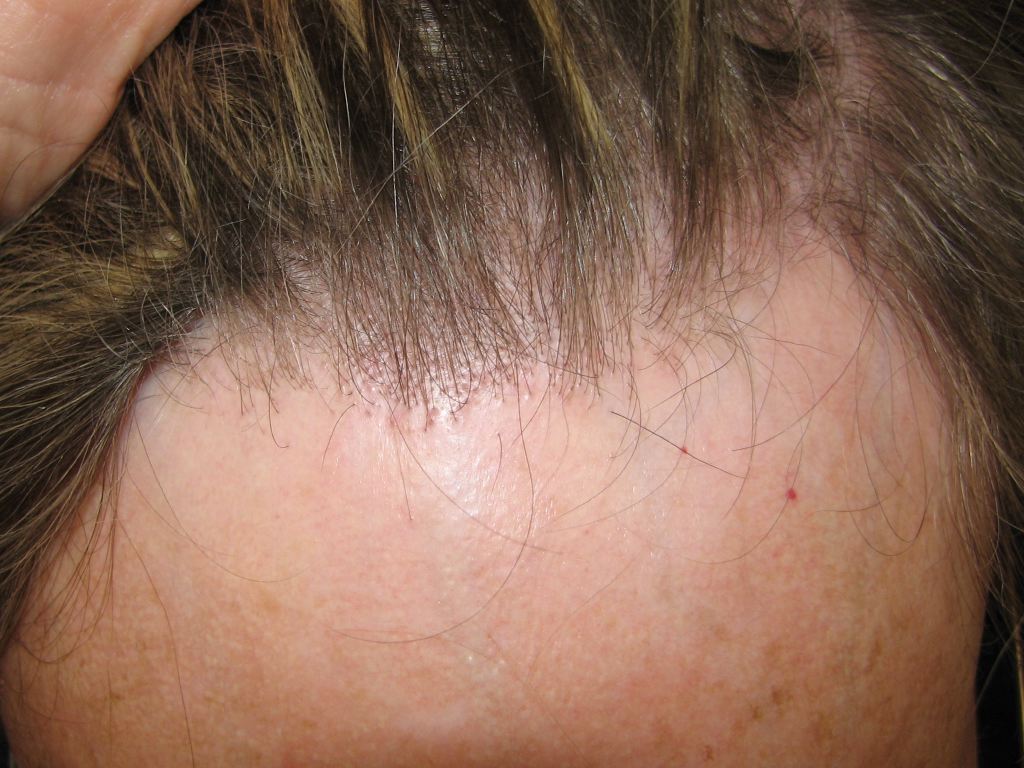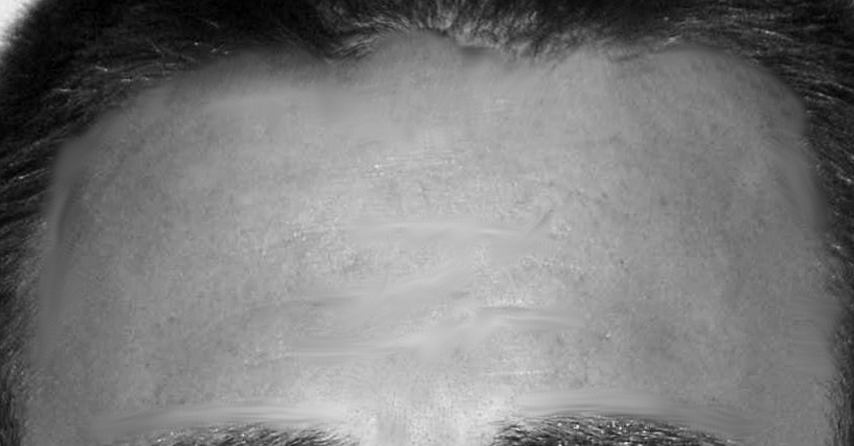[1]
Jouanique C, Reygagne P. [Frontal fibrosing alopecia]. Annales de dermatologie et de venereologie. 2014 Apr:141(4):272-8. doi: 10.1016/j.annder.2014.01.020. Epub 2014 Mar 6
[PubMed PMID: 24703641]
[2]
Samrao A, Chew AL, Price V. Frontal fibrosing alopecia: a clinical review of 36 patients. The British journal of dermatology. 2010 Dec:163(6):1296-300. doi: 10.1111/j.1365-2133.2010.09965.x. Epub
[PubMed PMID: 20698851]
[3]
MacDonald A, Clark C, Holmes S. Frontal fibrosing alopecia: a review of 60 cases. Journal of the American Academy of Dermatology. 2012 Nov:67(5):955-61. doi: 10.1016/j.jaad.2011.12.038. Epub 2012 Apr 13
[PubMed PMID: 22503342]
Level 3 (low-level) evidence
[4]
Tan KT, Messenger AG. Frontal fibrosing alopecia: clinical presentations and prognosis. The British journal of dermatology. 2009 Jan:160(1):75-9. doi: 10.1111/j.1365-2133.2008.08861.x. Epub 2008 Sep 22
[PubMed PMID: 18811690]
[5]
Nakamura M, Tokura Y. Expression of Snail1 in the fibrotic dermis of postmenopausal frontal fibrosing alopecia: possible involvement of an epithelial-mesenchymal transition and a review of the Japanese patients. The British journal of dermatology. 2010 May:162(5):1152-4. doi: 10.1111/j.1365-2133.2010.09682.x. Epub 2010 Feb 3
[PubMed PMID: 20132204]
[6]
Clayton R, Chaudhry S, Ali I, Cooper S, Hodgson T, Wojnarowska F. Mucosal (oral and vulval) lichen planus in women: are angiotensin-converting enzyme inhibitors protective, and beta-blockers and non-steroidal anti-inflammatory drugs associated with the condition? Clinical and experimental dermatology. 2010 Jun:35(4):384-7. doi: 10.1111/j.1365-2230.2009.03581.x. Epub 2009 Oct 23
[PubMed PMID: 19874335]
[7]
Chiang YZ, Tosti A, Chaudhry IH, Lyne L, Farjo B, Farjo N, Cadore de Farias D, Griffiths CE, Paus R, Harries MJ. Lichen planopilaris following hair transplantation and face-lift surgery. The British journal of dermatology. 2012 Mar:166(3):666-370. doi: 10.1111/j.1365-2133.2011.10692.x. Epub 2012 Jan 9
[PubMed PMID: 21985326]
[8]
Tosti A, Piraccini BM, Iorizzo M, Misciali C. Frontal fibrosing alopecia in postmenopausal women. Journal of the American Academy of Dermatology. 2005 Jan:52(1):55-60
[PubMed PMID: 15627081]
[9]
Katoulis A, Georgala, Bozi E, Papadavid E, Kalogeromitros D, Stavrianeas N. Frontal fibrosing alopecia: treatment with oral dutasteride and topical pimecrolimus. Journal of the European Academy of Dermatology and Venereology : JEADV. 2009 May:23(5):580-2. doi: 10.1111/j.1468-3083.2008.02963.x. Epub
[PubMed PMID: 19415810]
[10]
Vaisse V, Matard B, Assouly P, Jouannique C, Reygagne P. [Postmenopausal frontal fibrosing alopecia: 20 cases]. Annales de dermatologie et de venereologie. 2003 Jun-Jul:130(6-7):607-10
[PubMed PMID: 13679696]
Level 3 (low-level) evidence
[11]
da Silva Libório R, Trüeb RM. Case Report of Connubial Frontal Fibrosing Alopecia. International journal of trichology. 2018 Mar-Apr:10(2):76-79. doi: 10.4103/ijt.ijt_105_17. Epub
[PubMed PMID: 29769781]
Level 3 (low-level) evidence
[12]
Chew AL, Bashir SJ, Wain EM, Fenton DA, Stefanato CM. Expanding the spectrum of frontal fibrosing alopecia: a unifying concept. Journal of the American Academy of Dermatology. 2010 Oct:63(4):653-60. doi: 10.1016/j.jaad.2009.09.020. Epub
[PubMed PMID: 20846567]
[13]
Poblet E, Jiménez F, Pascual A, Piqué E. Frontal fibrosing alopecia versus lichen planopilaris: a clinicopathological study. International journal of dermatology. 2006 Apr:45(4):375-80
[PubMed PMID: 16650161]
[14]
Kossard S. Postmenopausal frontal fibrosing alopecia. Scarring alopecia in a pattern distribution. Archives of dermatology. 1994 Jun:130(6):770-4
[PubMed PMID: 8002649]
[15]
Miteva M, Camacho I, Romanelli P, Tosti A. Acute hair loss on the limbs in frontal fibrosing alopecia: a clinicopathological study of two cases. The British journal of dermatology. 2010 Aug:163(2):426-8. doi: 10.1111/j.1365-2133.2010.09807.x. Epub 2010 Apr 15
[PubMed PMID: 20394630]
Level 3 (low-level) evidence
[16]
Armenores P, Shirato K, Reid C, Sidhu S. Frontal fibrosing alopecia associated with generalized hair loss. The Australasian journal of dermatology. 2010 Aug:51(3):183-5. doi: 10.1111/j.1440-0960.2010.00653.x. Epub
[PubMed PMID: 20695856]
[17]
Rudnicka L, Olszewska M, Rakowska A, Slowinska M. Trichoscopy update 2011. Journal of dermatological case reports. 2011 Dec 12:5(4):82-8. doi: 10.3315/jdcr.2011.1083. Epub
[PubMed PMID: 22408709]
Level 3 (low-level) evidence
[18]
Chiang C, Sah D, Cho BK, Ochoa BE, Price VH. Hydroxychloroquine and lichen planopilaris: efficacy and introduction of Lichen Planopilaris Activity Index scoring system. Journal of the American Academy of Dermatology. 2010 Mar:62(3):387-92. doi: 10.1016/j.jaad.2009.08.054. Epub 2010 Jan 12
[PubMed PMID: 20061052]
[19]
Donati A, Assouly P, Matard B, Jouanique C, Reygagne P. Clinical and photographic assessment of lichen planopilaris treatment efficacy. Journal of the American Academy of Dermatology. 2011 Mar:64(3):597-8; author reply 598-9. doi: 10.1016/j.jaad.2010.04.045. Epub
[PubMed PMID: 21315955]
[20]
Wolff H, Fischer TW, Blume-Peytavi U. The Diagnosis and Treatment of Hair and Scalp Diseases. Deutsches Arzteblatt international. 2016 May 27:113(21):377-86. doi: 10.3238/arztebl.2016.0377. Epub
[PubMed PMID: 27504707]
[21]
Donovan JC, Samrao A, Ruben BS, Price VH. Eyebrow regrowth in patients with frontal fibrosing alopecia treated with intralesional triamcinolone acetonide. The British journal of dermatology. 2010 Nov:163(5):1142-4. doi: 10.1111/j.1365-2133.2010.09994.x. Epub
[PubMed PMID: 20716217]
[22]
Mulinari-Brenner FA, Guilherme MR, Peretti MC, Werner B. Frontal fibrosing alopecia and lichen planus pigmentosus: diagnosis and therapeutic challenge. Anais brasileiros de dermatologia. 2017:92(5 Suppl 1):79-81. doi: 10.1590/abd1806-4841.20175833. Epub
[PubMed PMID: 29267454]
[23]
Mirmirani P, Willey A, Price VH. Short course of oral cyclosporine in lichen planopilaris. Journal of the American Academy of Dermatology. 2003 Oct:49(4):667-71
[PubMed PMID: 14512914]
[24]
Cho BK, Sah D, Chwalek J, Roseborough I, Ochoa B, Chiang C, Price VH. Efficacy and safety of mycophenolate mofetil for lichen planopilaris. Journal of the American Academy of Dermatology. 2010 Mar:62(3):393-7. doi: 10.1016/j.jaad.2009.05.018. Epub 2010 Jan 12
[PubMed PMID: 20061053]
[25]
Jiménez F, Poblet E. Is hair transplantation indicated in frontal fibrosing alopecia? The results of test grafting in three patients. Dermatologic surgery : official publication for American Society for Dermatologic Surgery [et al.]. 2013 Jul:39(7):1115-8. doi: 10.1111/dsu.12232. Epub 2013 Apr 30
[PubMed PMID: 23631596]
[26]
Lacarrubba F, Micali G, Tosti A. Absence of vellus hair in the hairline: a videodermatoscopic feature of frontal fibrosing alopecia. The British journal of dermatology. 2013 Aug:169(2):473-4. doi: 10.1111/bjd.12316. Epub
[PubMed PMID: 23496000]
[27]
Conde Fernandes I, Selores M, Machado S. Frontal fibrosing alopecia: a review of eleven patients. European journal of dermatology : EJD. 2011 Sep-Oct:21(5):750-2. doi: 10.1684/ejd.2011.1419. Epub
[PubMed PMID: 21697058]
[28]
Dlova NC, Jordaan HF, Skenjane A, Khoza N, Tosti A. Frontal fibrosing alopecia: a clinical review of 20 black patients from South Africa. The British journal of dermatology. 2013 Oct:169(4):939-41. doi: 10.1111/bjd.12424. Epub
[PubMed PMID: 23647261]


